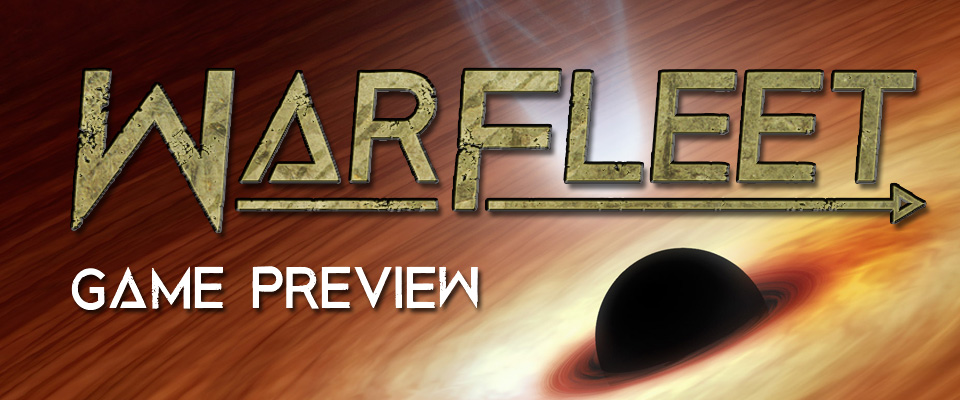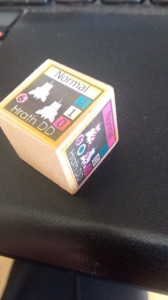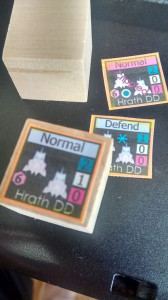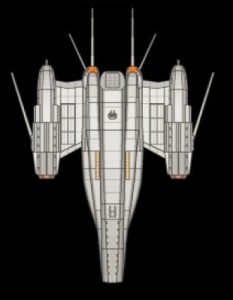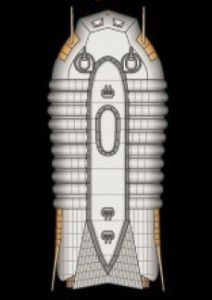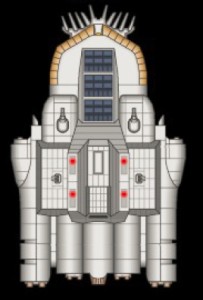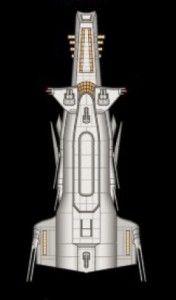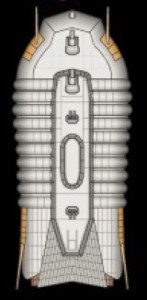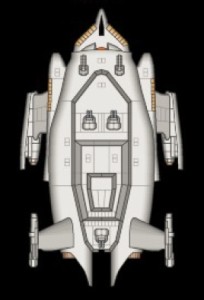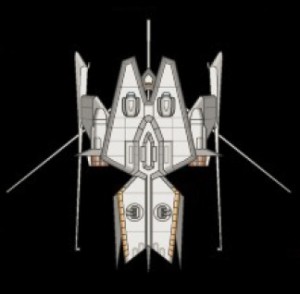
There are a lot of good starships games out there in all kinds of scales. The more I talked to players and we worked out the right system to resolve big battles it became clear that a true fleet system, one where the players took on the decisions of a fleet admiral, were noticeably vacant. I suppose the important distinction to make here is that there are many systems which allow players to run large numbers of ships, which I personally feel is a very different game than one with a player in the admiral’s role. I think it boiled down to a few simple things.
Scale
An engagement between massive starships fleets should probably consider the scale of such a fight. And not just the scale of the map, but what time scale are we looking at here. Some of my favorite wargames make similar considerations where a battle could represent several days across a swath of land. You can have several meeting engagements between fast units, followed by the clumsy slow units trying to break the enemy. I wanted War Fleet to examine that; a game that can place over an entire star system with a wide variety of units in their element for battles that can last a long time. Another way to think about it is that a game of War Fleet could represent a dozen of scenarios from our other favorite starship combat systems.
Representing the ships
What would a ship look like? First off at this scale it seems important that we stop representing individual ships that are too small. So ships like corvettes and destroyers would become a flotilla of ships that serve as part of a greater squadron. With War Fleet I tried to think of how an admiral would consider the effectiveness of these ships.
“Well there is a heavy cruiser with a bunch of escorts…”
So what? What does that really mean? That means a player is looking down, probably sees a CA block and a few escort sized blocks. We want War Fleet to represent how these feel to command, so we distill the important of these ships to how effective they are in combat and what special abilities they may have.
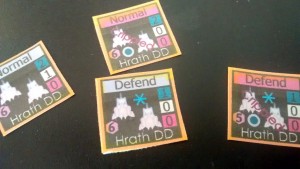
To me it was important to include the distinctions or the game would risk just being another vanilla combat system. We need subtle differences to separate one generation of CA’s from another or even the CA’s from one empire to another. This become obvious to me after continuous testing in War Fleet; we wanted to represent the combat ability, movement, special abilities, and damage state on a wooden block in something in the game we call the configuration.
It remains important that we don’t get bogged down in ship level details. Remember the admiral is not firing the weapons on these ships; he or she has competent squadron commanders and ship captains to do that. We don’t need to know that a MagHur Zara corvette typically has short range auto-cannons and one-shot box launchers that fire a concentrated salvo of a kinetic scatter shot weapon. These are important, but to an admiral it is about how and where this ship is effective. In War Fleet this ship becomes a escort sized block representing several ships, its speed, the the various block configurations that represent what can be done with the ships.
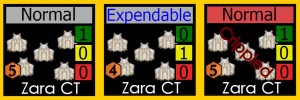
Zara CT as of 12/15/2015 playtest
One cruiser from an advanced empire may have a lot of detail we don’t see at the scale, but that should still be important. That is where the configurations come in. For example, one empire may have a generic, cheap to construction bulk cruiser. In combat it may be ok at taking damage, and dealing damage at close range. There is just only so much you can do with it. An admiral, knowing that, has only a few decision points to consider with the cruiser. It is either damaged, or not, and maybe you can order the squadron commander to increase speed at the cost of effective firing, but what you can do with the ship is effectively represented without breaking out a detailed ship sheet.
Another empire may have a heavy cruiser peppered with long range missiles, flexible movement system, and defensive systems. This is handled equally well as the admiral can order the squadron commander to use this by changing the configuration on the cruiser. The cruiser, in Expendable mode, may be able to empty its long range missiles before the fight. These are things the admiral would care about, and would set this cruiser apart from another.
Squadron Command
A battlefield is controlled chaos. With players representing admirals we want to reflect the effectiveness of their command and control. Some admirals are better than others, and those admirals will have more control of their situations by having more control of the dice within the dice command pool. The admiral passes these orders along to the squadron commanders, who execute them. A squadron is simply the blocks in a hex representing a large group of starships of varying type and ability.
So, what about the units not being closely commanded by an admiral? While the admiral is enacting his battle plan the units on the board are still organically responding to the situation they are in with less effective, but still executing commands from the player. We refer to these as standing orders; the directives given to squadron commanders who can’t see the big picture.
Special Abilities
Some abilities go beyond the basic ability of a ship to hit another ship, such as stealth ships, scouts, and carriers. We had to tackle each of these as they came up, but again, wanted to focus on the overall battlefield affect of such a unit. An admiral cares about how his carrier is being used and not where each individual fighter on the map. Each of these special abilities, again controlled by the configuration of the ship blocks in question, is how this is achieved.
For example a player wants to use his carrier. Being part of a squadron the player could activate the unit, and configure the carrier to be used in a long range strike against another squadron. He could simply want to deploy interceptors to make sure the enemy doesn’t do the same to his own squadrons. Once we had the idea ironed out it was easy to include carrier heavy fleets in the game without a lot of overhead in time.
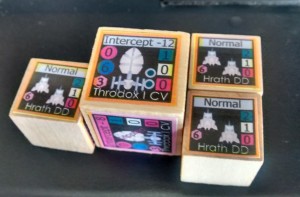
A Boltian Star League Squadron centered around a fleet carrier about to deploy a lot of interceptors. Please note 7 ships, a massive star fighter force, and minimal effort.
Expanded Audience
VBAM Games, Inc wanted to make a game that works with a wider audience of gamers. War Fleet is a tabletop starship block game that plays quickly, captures the feel of fleet engagements, and is accessible to many of our friends who don’t want the commitment of a day long starship battle game.
Production
We have a process designed to bring the game to market through our store. War Fleet has been in development for several years, online playtesting for one, and is currently in physical playtesting with the full components. Some more assembly will be required than a typical off the shelf game, but War Fleet will open a world of starship combat gaming to your game group that can represent a vast array of scifi settings. After the initial product release we play to support the game with more fleet packs and scenario books. The goal is to also make blank counters and blocks available to you so you can design your own settings and battles. The initial release delves deeper in to the Wars of the Boltian and Kuissians, a popular VBAM Games setting with a treasure trove of scenarios and fleet styles to explore.
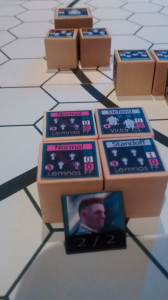
A Vidar CL block prepares to defend the squadron.
A Note to Campaign Players
Most of our current player base has found us through our strategic campaign system. Well, many of these attributes in War Fleet may be familiar to you. War Fleet is designed to work within your campaigns. The ships you built in your campaigns will convert to War Fleet units, including all the special abilities of your ships. This will be discussed further once War Fleet is released.
Meet the ships of the fleet – The Terran Union
Here are a few of the favorites from the playtest pack….
Carthage Heavy Cruiser
This vessel is the well-received heavy brawler of the Terran Navy. The hull and drive system were originally proposed for the newly designed Toltec class heavy freighter hauler (which incidentally never saw service), but were converted by Navy technicians at the Terran Loki Shipyards near Earth for use as a warship. Resembling most Terran cruisers in battle doctrine with a respectable number of medium range weapons, the Carthage class gave the navy a good, cost-efficient capital ship .
Kagero Destroyer
Where ships like the Tonala class destroyer carry longer ranged missile type weapons, the Kagero class is designed to deal out damage with short and medium range weapons. After several years of major production at the Union yards at Deimos and Spica, the Kagero class was quite numerous. It pushed the aging Wales destroyers out of service with the addition of improved point defenses that would prove invaluable in the coming war.
Huron Escort Carrier
This is the newest carrier-type vessel to be added to the Union arsenal. During the opening months of the war, the Terrans suffered heavy damage to fleets that could not deploy adequate defense against Boltian fighters. It would not be uncommon for wings of Boltian fighters to cripple many Terran warships before they could respond. The quick answer to this was the alteration of the Republic class heavy transport to serve as escort carriers in fleets where a traditional fleet carrier type ship could not be deployed. The flights of fighter-drones brought to the defense of Terran ships from Huron class ships have mixed results, with the most important being the deterrent of Boltian fighter raids from the appearance of some Terran fighter defense.
Sverige Cruiser
This heavy warship design is widely used and is probably the most capable Terran ship existing at the time of the encounter at Rappahannock. The Sverige Cruiser is equipped with respectable missile tubes, good stand-off weapons, and maneuverability. The Sverige class is often used as a deputy command ship for many squadron commanders who prefer its enhanced sensor suite. It is also one of the first ships Terran Fleet Command decided to overhaul in the war. Even though an excellent Terran warship, it still is outmatched by its counter-parts in the opposition.
Tonala Destroyer
Even for a Terran warship, the Tonala Class Destroyer is missile heavy. It is designed to skirmish at range, harassing wounded ships. It is also a staple in the standard Terran battle fleet, and is an able warship in terms of escort functions. The limited storage space available for ammunition often forces the vessel to engage at closer ranges than missile combat usually dictates.
Vidar Light Cruiser
The Vidar Light Cruiser was one of the designs that resulted from the adoption of a unified fleet doctrine as the Terran Navy moved deeper into space. The concept behind the ship was for the deployment of a screening vessel that could support escort squadrons on attack runs, or defend larger vessels from nimble opponents. The ship is well armed but suffers from a weak armor belt, a sacrifice made in exchange for improved maneuvering capabilities. Kuissian lances had no trouble punching through to the ship’s’ critical systems, crippling them in the opening volleys of an engagement. Their point defenses are what kept them in service until the Improved Vidar Class could be launched a number of years later.
Lemnos Improved Frigate
This successor design to the Lemnos Frigate was the first vessel to field the new Kinetic Perimeter Defense System. With limited offensive weapons of its own, the newer manifestation of the ship is designed to keep fighters and missiles at bay. It is usually paired with Kagero and Tonala class destroyers to provide the Lemnos defense against enemy capital ships.
